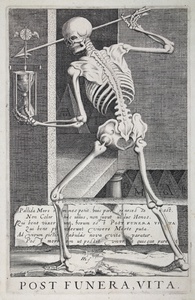| Method | Copper engraving |
| Artist | Hendrick Hondius |
| Published | Hagae-Comitis. Ex Officina Henrici Hondii. Cum Privilegio [The Hague, c.1610]] |
| Dimensions | Image 205 x 130 mm, Plate 210 x 135 mm, Sheet 280 x 185 mm |
| Notes |
A memento mori endpiece to Hendrick Hondius' Pictorum aliquot celebrium praecipué Germaniae Inferioris, Effigies, a collection of portraits of Flemish artists, engravers, and sculptors. In the centre of the scene, a skeleton stands, its back to the viewer, holding a long dart and an hourglass topped with a winged clock, familiar symbols of death and the rapid passage of mortal life. Unlike many works in the memento mori genre, which emphasize Death as oblivion and the ultimate reward for all human endeavour, this scene suggests that some rare things do outlast even Death. Behind the skeleton, a large funerary vault contains pyramidal epitaphs emblazoned with the monograms of the Old Masters, including Durer, Lucas van Leyden, and Aldegrever, men whose works have outlived their mortal bodies, their fame granting them a rare modicum of permanence in the gradual ebb of human life. The title of the piece, 'Post Funera, Vita,' is quite literally an exultation of the 'Life after Death' that artistic genius bestows. Behind the skeleton, a funereal inscription has been pasted onto the threshold of the tomb: Pallida Mors omnes petit, huic parere necesse est. Non Color hic ullus, non juvat ullus Honos. Qui bene vixerunt, horum est Post Funera Vita: Qui bene pinxerunt vivere Morte puta. Ad vivum pictis tabulis nova vita paratur. Post mortem ut possit vivere quisque paret. - 'Pale Death seeks all things, and all must submit to him. No man's excuse, no man's honors, will satisfy him. But for they who have lived well there can be life after death: Consider those who painted well, that they live on even in Death. Through their paintings, a new life is gained from the living. Thus may each man intend to be able to live after death.' Hendricus Hondius or Hendrik Hondius I (1573-1650) was part of a Dutch family of printmakers from Flemish descent, and was active as an engraver, etcher and draftsman in The Hague. He travelled to work in Amsterdam and Leiden around from 1603 to 1605, but then settled permanently in The Hague, in his "Buitenhof Ten Huyse". He had a cousin with the same name, active in Amsterdam, and the distinction between the two is made by naming the first one Hendrik Hondius I and the cousin Hendrik Hondius II (c. 1597-1644), which often leads to confusion in literature about them having a father-son relationship. New Hollstein 115 Condition: Light horizontal crease to centre of sheet. Minor surface dirt and foxing to sheet. Manuscript '192' in top right corner of sheet. Framed in an 18th century black frame. |
| Framing | framed |
| Price | £2,250.00 |
| Stock ID | 49616 |

